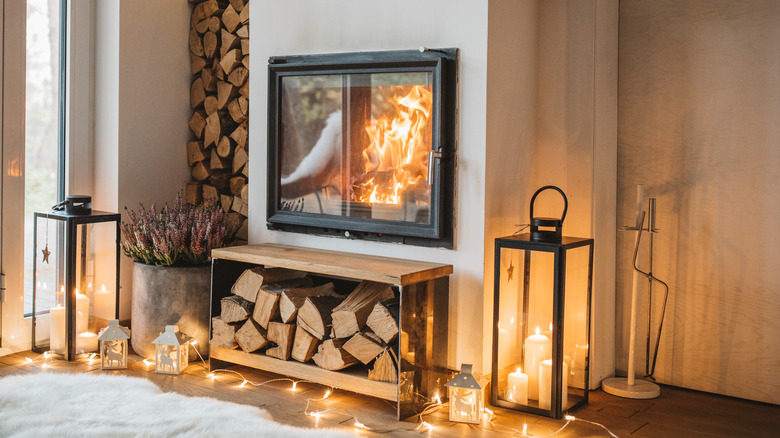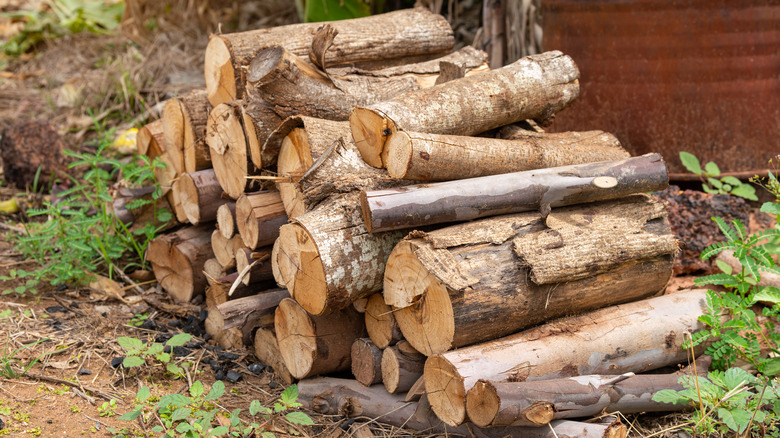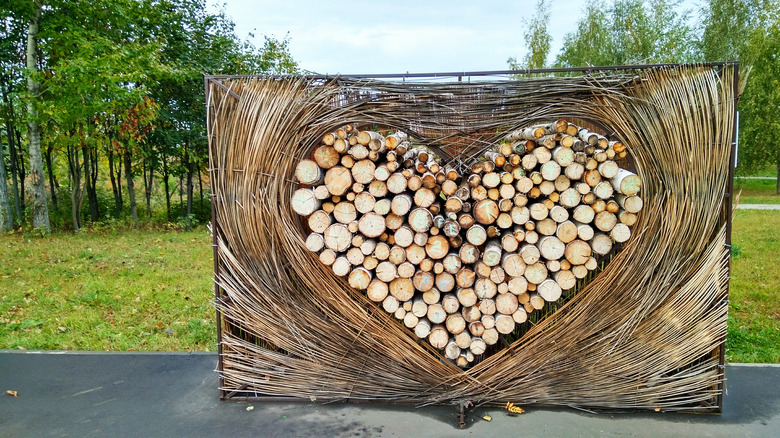Why You Should Never Store Your Firewood Indoors
Contrary to some recent interior design trends, it is not a good idea to store firewood inside your home — unless you are willing to share your space with termites, carpenter ants, or wood-boring beetles. Indoor woodpiles have recently morphed into a form of artistic expression, per Manna Gum, but these displays invite a host of potential problems and are often better kept outside. Bringing firewood indoors for immediate use is one thing; storing an entire pile inside is something else entirely.
Storing wet wood inside is also an invitation for a mold infestation. Mice and voles might move into your indoor woodpile, too. Firewood is thus best stored outside, ideally in an adjustable, well-ventilated, and polyester-covered rack, according to Shelterlogic. Ideally, the pile should be elevated and placed several yards away from the home, and never stacked against your house or trees. If you don't want to trudge outside to fuel your fire and insist on storing firewood indoors, there are ways to minimize the risks.
What to do
Wood that ignites with ease and burns evenly and cleanly is the best to use in your fireplace. Keeping firewood dry is essential, and preventing pest infestation is a priority. Bring only one or two days' worth of firewood inside, and don't keep it in the house for an indefinite period. Thoroughly inspect any wood kept inside, and remove any visible webs or cocoons. Shake and bang every log together — a hollow sound may be a clue to termites and you might even hear clicks and other sounds. Look for holes in the logs or examine tunnels or sawdust piles around the outdoor stack, advises Home Pest Control, while placing ant or bug traps around it is also a good idea
Your fireplace container needs to be of functional size and have adequate airflow, explains Cottage Life. It should neither hold too few nor too many logs, for accessibility and to lessen the need for repeated trips to the outdoor pile. Lining the container with a mat will protect it, and to minimize the risk of infestation in wood that has been sitting too long, use the oldest logs first, and shuffle the outside pile from time to time for easier access to it suggests Batzner Pest Control.
What not to do
According to The Gleaner, individual insects are not worrisome, but by storing wood inside, you may be unwittingly harboring an existing colony. Single bugs can be vacuumed up, put outside, or otherwise eliminated. Should you spot an insect, don't reach for the insecticide. Wood borers will simply dig deeper, and you will taint the firewood with a flammable and toxic substance.
If you are storing any wood inside, avoid using a damp location such as a garage or basement, whose walls may be moist enough for insect pests to invade. Firewood should come from within a 50-mile radius to avoid transporting invasive species such as the Asian longhorn beetle or emerald ash borer, warns ThoughtCo. – violating this limit may also be illegal, so it is advisable to learn and adhere to local firewood regulations. Consumer Reports advises that wood purchased at grocery stores, gas stations, or hardware stores may have to be dried before use, especially if it is wrapped in plastic. Besides being difficult to burn, the unseasoned wood will generate creosote and tar in your house, chimney, and flue.
Rather than following some of the creative woodpile designs reported on by Remodelista, such as benches constructed from wood cords, indoor stacks with painted ends, or artful firewood insets in walls, it may be best to confine those trends to the outdoors. Or create an artistic artificial woodpile indoors to simulate the same rustic, but pest-free, effect.


